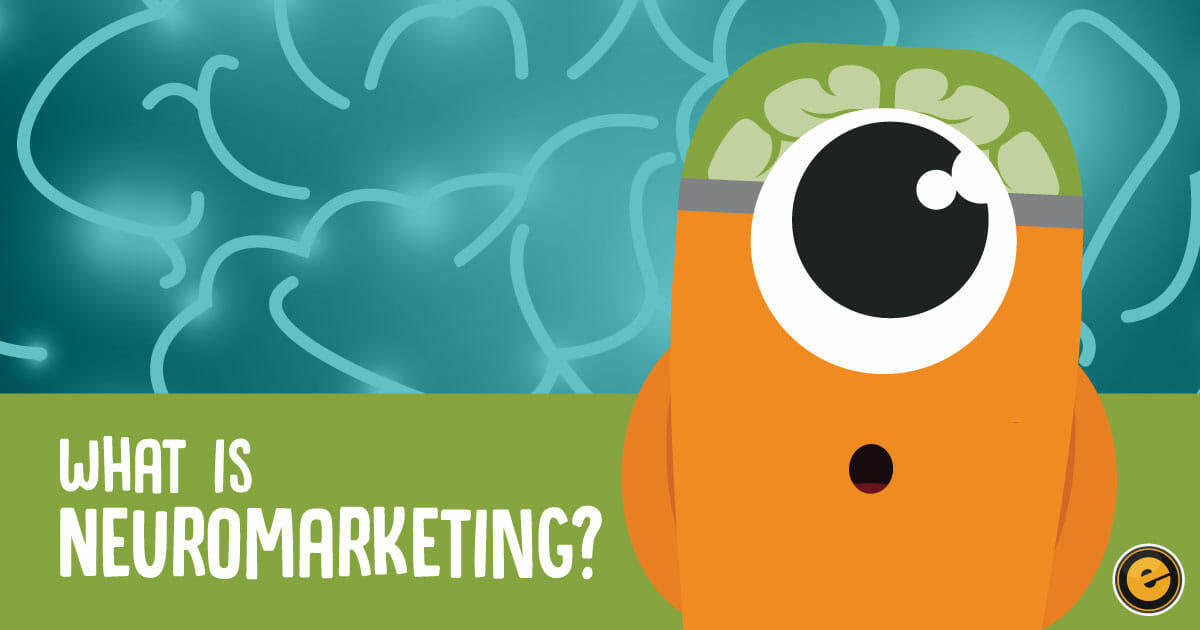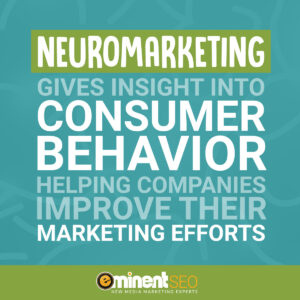
Neuromarketing has been around for a few years now, and regardless of whether you’re familiar with the term, you’ve probably read or heard about some of the insights marketers have learned from it.
But what is neuromarketing really, and how much do you need to know about it? Is it replacing traditional marketing research, as some have suggested, or is it just a passing fad?
Getting Into the Minds of Consumers
Neuromarketing is simply neuroscience applied to marketing. Researchers use technologies that observe brain activity and biometrics (such as heart rate, eye tracking, galvanic skin response, facial coding, etc.) to determine how people respond physiologically to marketing messages.
Neuromarketing examples might include:
- Tracking eye movement to see which parts of a webpage grab the user’s attention first
- Using EEG imaging of the brain to determine one’s emotional response to an ad or product
- Determining which version of an ad generates the most brain activity, as seen in an fMRI scan
The goal of neuromarketing is to better understand consumer behavior by gaining insight into the reactions and decision-making happening at the unconscious level. Since 90 percent of the information that comes into the human brain is processed unconsciously, neuroscience gives us valuable insight into automatic human responses that influence consumer behavior.
By contrast, traditional marketing research methods involve consumer surveys, focus groups and external observation to gather data about what people think, feel and believe. These traditional methods are better at revealing conscious decision-making processes.
The Pros and Cons of Neuromarketing

On the other hand, because these findings are so generalized, there is still a need for traditional research to understand a target audience in greater detail. And even though consumers’ decisions can be greatly influenced by their subconscious responses, what they consciously think and feel still matters – a lot.
Neuromarketing can be used to help your marketing messages appeal to human beings as a whole, while traditional methods help you hone your message for a specific audience.
You will still need to do plenty of trial and error to see what actually works for your target audience, in your market, with your products. Sorry, neuromarketing is not a magic bullet. Honing in on an optimized marketing strategy will always involve work.
Advantages of Neuromarketing
The biggest advantage of neuromarketing is that it can fill in the gaps left by traditional marketing methods, because neuromarketing provides insight into situations where consumers say they want one thing, but then act (i.e., buy) in a different way.
Neuromarketing has an advantage because it:
- Does not rely on consumers to willingly and accurately report emotions,
- Can closely tie physiological reactions to specific parts of an ad or message, and
- Provides insight into automatic responses that take place at the subconscious level.
Limitations of Neuromarketing
However, it’s important to keep in mind that variances in how individuals process information and the limitations of testing can make it difficult to generalize results with certainty. Limitations include:
- The high cost in doing neuromarketing research means it is conducted with small sample sizes and often funded by corporations, which could introduce bias into the results.
- Since brain science is still evolving, there’s not a completely reliable way to connect the marketing stimuli to the emotions triggered.
- Reactions observed in a lab test environment may be somewhat different than they would be in an actual buying environment.
For more information on how neuromarketing works, check out this enlightening TEDx Talk by SalesBrain cofounder Patrick Renvoise:
Why We Need Neuromarketing AND Traditional Marketing
A key point to remember is that people are naturally contradictory in nature. Human beings often say one thing and do another, and think one way and feel the opposite at the same time. We also may hold one view consciously while subconsciously believing something else.
This doesn’t mean that all people are hypocrites. It’s just that humans are complicated creatures with many competing desires, who live in a world where we’re constantly being sent conflicting messages. In fact, one of the biggest opportunities for marketers is to help relieve this internal conflict – either by guiding people through their options so they can make a clear decision, or by providing a new option that allows them to have their cake and eat it too.
Although all the stimuli humans encounter are filtered through the unconscious processing system first, the conscious decision-making process is also important. Traditional marketing research has given us plenty of valuable insight into why people make the buying decisions they do – or at least why they think they make them.
So while it may be tempting to get caught up in a debate over which type of research gives us better data – traditional or neuromarketing – savvy marketers would be wise to utilize both, because each method measures different factors and gives us different information, all of which is valuable to some degree.
Findings from Neuromarketing Research
The neuromarketing field is still new, and much of it has confirmed things that we already knew either through observation and experience or via traditional marketing methods. Few studies have been published, and the companies that are doing their own research aren’t often willing to share their findings.
Some of what neuromarketing has revealed is unexpected, but most is not. For example:
- Emotions drive biases and subconscious decision-making.
- Visuals are processed more quickly than words.
- Images of celebrities, beautiful women, children and puppies are universally appealing.
- Faces of any type draw the eye better than other kinds of visuals, and convey important emotional information such as mood, status, etc.
- Messages that consumers find irrelevant reduce their positive responses.
- Marketing elements that consumers can personally identify with create a positive response.
- When a consumer purchases a product from a brand he or she is loyal to, the reward center of the brain gets activated.
- Prices with round numbers (like $100) are processed more easily, yet numbers like $99.99 are perceived as a better deal.
- Certain colors elicit particular emotional reactions.
- The first and last parts of a message are especially important in setting the context for how a message is perceived.
- Social norms such as reciprocity can be invoked to influence behavior.
- Avoiding pain is often a stronger motivator than seeking pleasure.
Conclusion
Neuromarketing is a new and evolving science that can help marketers better understand consumer behavior in order to improve their:
- Packaging
- Pricing
- Brand positioning
- Promotion strategies
- New product development
Both traditional and neuromarketing research can give us valuable insight into how humans process information and make decisions, consciously and unconsciously. As the science of neuromarketing improves, more reliable results should be available in the future.
However, information from both sources will always need to be applied thoughtfully and strategically, taking into account a company’s unique target audience, market, products and goals. Along with this will be the need to test out best practices in specific situations to see what’s really working.



very interesting. I did notice that grocery stores use “neuromarketing” but i didn’t realize there was an actual term for it.
Maybe we’re exposed to the grocery store neuromarketing more than any other kind? lol
Heat maps and eye tracking technology are tremendously beneficial to conversion optimization. If you can study where the eye gazes, you can fine tune your calls to action and improve conversions. I love neuroscience and the emotional response to things like images, color, font size, etc. Smart marketers and designers would do well to study more on the science of the brain. Great post Sara!
Thanks Jenny! Yes, the world of the brain is fascinating, especially the insights into why people do contrary things. On the flip side, I found it interesting how much of what we’ve learned through neuroscience is stuff that marketers have been doing for years… now we know more about why things work the way they do.
It’s crazy how marketing can literally be taken down to a science. This topic is so cool. Thanks for sharing!
Sounds like a solid marketing strategy should be driven by both methods. However, due to the methods needed to gather neuromarketing data – it is not easy for just anyone to get the information they need. We are left to the findings of others, and with no control over the method or audiences used to gather this information – we cannot guarantee that it is indeed useful to any particular strategy.
These findings are more of an overall guide to what science has determined to be the “norm” and a good marketer will know how to utilize these generalizations along with traditional marketing analysis to create a successful strategy and campaign.
Psychology is such a big part of business and marketing… most forget this.
The most interesting take away from me is the idea of using biometrics and brain activity to “correct” the the desire that was expressed by customer (in certain contexts). This really changes the way that we conceptualize customer choice if this technology becomes part of the mainstream.
The idea of neuromarketing is also interesting from the retail perspective. A large number of retail executives have been sold on the advantages of beacons and proximity marketing, which take advantage of the ubiquity of smartphones to create new connections between a brand and the customer. This beacon technology is just around the corner from becoming a major staple of major retailers. I wonder how this technological trend with overlap with the rise of neuromarketing.
That’s a smart answer to a tricky question